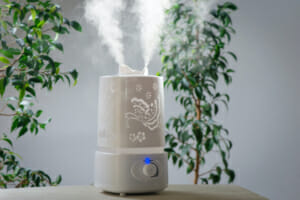Ideal Humidity in House – Indoor Humidity Levels
At Lockhart Industries, we never underestimate the importance of maintaining balanced humidity levels in ours or our clients’ homes. In addition to playing a key role in temperature regulation, humidity also significantly impacts the quality of the air we breathe. 
Humidity depends on water vaporization and condensation, both of which are dependent on temperature. External environmental factors such as weather and the overall climate of your region, as well as internal environment factors including ventilation, insulation, and temperature control, all have a direct relationship with humidity levels in your home.
It is widely believed that indoor humidity of 30-50% is optimal for maintaining our overall health and comfort. It only takes between 1 and 3 litres of water to raise indoor humidity levels from 15% to 60% in the average 1,000 square foot home. That’s a 45% increase in humidity just by boiling a pot of water!
But before we get into the specifics of how to identify and moderate humidity levels in your home, let’s talk a little more about how humidity impacts our comfort and our health.
Humidity and Human Comfort and Health
Generally speaking, humans are more sensitive to temperature variations than we are to relative humidity. But have you ever noticed, on a particularly humid summer day, it somehow feels hotter than the actual temperature indicates? Or perhaps, you struggle to stay warm during the “damp cold” of our west coast winters? That’s because the human body uses evaporative cooling as a primary mechanism for regulating body temperatures, and our perception of warm or cold has more to do with the rate of heat transfer from our bodies than it does the actual temperature itself.
The rate at which moisture evaporates from the skin is lower in humid conditions than it is in dry conditions. Take that humid summer day, for example. When we are warm, our bodies perspire and the evaporation of sweat from our skin helps to cool us down. But if the air is already saturated with water particles, the sweat on our skin cannot evaporate and so we are unable to effectively cool ourselves.
In cold weather, we stay warm by using layers of clothing to help trap warm air generated by our bodies. It’s much more efficient to transfer body heat to air than it is water and we’ve already established that moisture evaporating from the skin has a cooling effect. That means, when cold air has a high water content (think weeks of coastal winter rain), frigid water molecules get trapped in our clothing and on our skin, leaving us with that “chilled to the bone” feeling.
But when it comes to humidity, it’s not just temperature regulation that deserves attention. Humidity also impacts air quality, which can have a considerable effect on our health and respiratory comfort. In our homes, air which is too humid enables dust to cling more effectively to surfaces and creates an ideal environment for viruses, bacteria and mold to flourish. Humidity levels that are too low present another set of challenges, contributing to dry and cracked skin, itchy eyes and sinus irritation and can exacerbate allergies. Those with pre-existing respiratory issues, like asthma, may experience increased symptoms on either end of the humidity spectrum.
So, now that we better understand the relationship between humidity and our personal comfort and well-being, let’s look at how to determine humidity levels and what we can do to increase or decrease humidity in our homes.
Is My House Too Humid or Too Dry?
Most of us don’t have a humidity or a dew point meter kicking around the house; if you do, then you’re ahead of the game! So how can we monitor humidity levels in our homes on an ongoing basis?
Excess humidity is often easier to identify. Visible condensation on cooler surfaces like windows or mirrors, wet stains or peeling paint on the ceilings, and even excessively creaky floorboards can all be indicators of excess moisture in the home.
Determining a lack of sufficient humidity can be a trickier proposition and often only becomes evident with an increase in health-related symptoms such as those cracked, bleeding noses we sometimes get in the winter when indoor heating dries the air too much.
There is one simple test you can use that will provide you with a basic idea of your indoor humidity levels and that’s the Ice Cube Method. For this test, fill a glass with water, place two to three ice cubes in it and wait about four minutes. If, after the four minutes has passed, the glass has condensation dripping down the outside, your humidity levels may be too high. On the other hand, if there is no condensation forming on the glass, chances are your humidity levels are too low. You’re looking for condensation but not so much that it’s dripping down the side of the glass.
So, you’ve had a look around your house and done the Ice Cube Method and determined that your humidity levels need attention – now what? Here are some great tips to increase and decrease moist air in your home.
5 TIPS ON HOW TO DECREASE HUMIDITY IN YOUR HOME
- Home improvements. Weatherstripping, caulking, insulation and windows play an integral role in your home’s ability to moderate humidity and temperature levels. Also, carpets and curtains are known to hold moisture, so replacing those with tile or wood flooring and blinds can help.
- Use those exhaust fans. When you’re having a shower or boiling that pot of water, make sure you have an effective way to counteract the moisture being released into the air. Exhaust fans in the bathroom and hood vents over your stove are key, and should be kept clean and in proper working order.
- Shorter, cooler showers. A great way to keep humidity from creeping up is to have shorter showers and avoid the urge to crank up the hot water. You’ll be doing your home a favour and conserving energy and water while you’re at it.
- Get some more plants. Indoor plants are a great natural humidity absorber and they also make for some lush and beautiful decor.
- If you have an air conditioner, be sure to keep those filters clean!
5 TIPS ON HOW TO INCREASE HUMIDITY IN YOUR HOME
- Turn those exhaust fans off. If having them on helps mitigate moisture in the air, then turning them off will achieve the opposite. Also, be sure to leave that bathroom door open when you shower to help that moist air move through the house.
- Invest in a humidifier. Hit the easy button and get yourself a large room humidifier to help release extra moisture in your home.
- Hang your clothes inside to dry. As your clothes dry, the moisture will be released into the air increasing the humidity. You’ll also be saving on energy and helping your clothes last longer!
- Get some more plants. Yup, it works here too. In addition to absorbing moisture from the air, plants will also transpire excess moisture.
- Place open containers of water around the house. This is particularly effective in the winter months when we tend to keep our indoor heating on blast. As the water evaporates, the humidity levels will rise.
Of course, one of the best things you can do to help regulate humidity in your home is to invest in an efficient indoor environment controlled system and this is our specialty. Whether you’re looking at GeoExchange, an air source heat pump or other climate control solutions, Lockhart Industries can help you stay healthy and comfortable in your home.
Easy Financing with…
Start Saving Money NOW! There’s no need to putting off a more Energy Efficient, Cost Effective home comfort system. We make it simple!
With Financeit you can:
- Make additional payments any time without penalty.
- Get a lower payment by choosing an amortization period of up to 180 months. 7.99% to 11.99% interest rate.*
- We add a small fee to the loan amount. There are no hidden or additional charges
- Bank-level encryption (AES-256 bit SSL) to protect your personal information.



